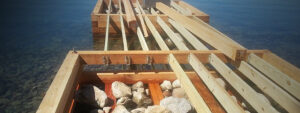Loading dock areas are some of the most hazardous parts of a facility. Workers and lift truck operators can suffer injuries due to ramps and inclines, dissimilar surfaces often wet or slippery, trailer creep, and other hazards.
To help reduce these risks, select a dock lift that offers safety features such as bow stops and motor stops. Dock Lifts Charleston SC full-length guide-ons help ensure a boat is properly positioned front to back and side to side.

Safety Features
Loading dock lifts are a great way to enhance loading dock efficiency. They can help increase productivity and reduce back injuries that often occur at the loading dock due to repetitive movement or sudden movements of heavy equipment and materials. Effective dock lifts help minimize the onset of these injuries by decreasing whole-body vibration. Additionally, they create a smooth transition between the dock and trailer allowing workers on forklifts to pass between them with minimal effort and discomfort.
To further ensure safety, it’s crucial to choose a lifting system with various built-in features. These include safety legs and dock ramp stops, hydraulic failsafe protection, full-range toe guards, and dock impact barriers.
Dock ramp stops protect the ramp from lowering too low and potentially trapping a vehicle or employee. They can be mechanical or hydraulic. Mechanical dock ramp stops feature a push-button control to stop the cylinder at any time. Hydraulic dock ramp stops feature a velocity fuse to prevent accidental lowering and an emergency ramp stop for immediate and manual intervention.
Guard rails are also a useful safety tool, as they can keep employees and forklifts away from areas where they aren’t supposed to be. They’re especially beneficial in areas with high-rise facilities or where there is limited space between structures. Bollards are another type of safety device that serves the same purpose, but they’re more commonly found in warehouse environments and can be placed around machinery or at building corners to protect them from accidental impacts by forklifts.
When it comes to loading dock accidents, forklift roll-offs are among the most devastating. They can easily happen when a truck pulls away from the dock (whether it’s due to trailer creep or if the driver isn’t paying attention). These incidents are often fatal, which is why it’s crucial to install a wheel chock on your truck and use one every time you enter the dock area.
Properly storing dock lifts will also help prevent trailers from moving away from the edge of the dock or opening the dock door and creating a gap that workers or forklifts can fall through. In addition to ensuring proper storage, employers should develop traffic control plans and train all employees who work in dock areas to understand them.
Guardrails
Guardrails on a dock lift provide a physical barrier and visual warning for all personnel. They protect expensive equipment, define traffic patterns, and shield key work areas from forklift traffic. They’re a powerful safety measure and help facility managers establish consistent behavioral expectations for staff around the loading dock area. Wildeck’s Wilgard(r) guard rail system is the industry’s best and has been tested to withstand severe impact from forklifts and other vehicles. This guardrail system is easy to install, add on to, or remove and features a 42″ double guard rail that meets OSHA guidelines for fall protection. It’s also painted a highly visible bright safety yellow.
For a more permanent, yet convenient solution, consider the option of pocket-style guardrails on your dock lift. These are easily removed by hand tools and don’t require any cutting of the steel guardrails. For example, if you have a truck that backs over your dock lift to a conventional trailer you can use the dock leveler and then pull the pocket-style guardrails up and away. When the truck departs you can quickly and easily put them back in place.
If you want additional personal safety on your dock lift beyond that required by OSHA, consider an advanced electric toe guard. This is an electrically operated toe guard that stops the downward movement of a platform when it is struck. The platform can then be raised to the proper dock height using a simple push of a button.
Other safety options for a dock lift include the addition of an axle rating capacity that identifies the maximum vehicle axle weight allowed to drive over a fully lowered dock lift. Most recessed units have this feature built in and it’s also an option on some surface mount dock lifts.
Wheel Chocks
One of the most common lower-tech safety features on dock lifts is wheel chocks. These wedge-shaped blocks help prevent trailer creep while a lift truck is loading it, which can cause gaps between the trailer and the building or even forklifts to fall off of the dock (7% of all reported forklift accidents involve trailers).
While OSHA regulates the use of wheel chocks at every loading dock where trucks load and unload, most facilities don’t take full advantage of this simple yet important safety measure. This is often due to time constraints and communication breakdowns between truck drivers, lift operators, and dock workers that lead to early truck pull-aways and trailer departures before the trailer is fully loaded.
If you’re looking for a more efficient and effective alternative to manual surface wheel chocks, consider this innovative restraint that uses an interlock-capable control panel, standard LED communication lights, exterior audible alarms, and safe engagement sensors to communicate with the vehicle driver. Unlike traditional wheel chocks that require physical placement by employees, it has an automated arm that engages near the axle height to ensure better capture and can restrain up to 32,000 pounds of force.
In addition, its patented design makes it easier to install by simply placing it on the ground and putting the vehicle in park. Once it’s in place, the lift system automatically engages to secure the trailer to the dock without the need for employee intervention. This can greatly reduce the risk of accidental trailer drift and unauthorized departures during transshipment that put both employees and cargo at risk.
It is also ideal for warehouses and distribution centers that need to secure a variety of different types of trailers, including pup and lift gate trailers that have damaged rear impact guards or different axle configurations. With the ability to be manually or hydraulically operated, this high-performance restraint can keep virtually any trailer parked safely at your dock, whether you’re working in a manufacturing, distribution, food service, or retail environment. Contact a product specialist to learn more about this versatile wheel chocking solution and how it can make your warehouse dock safer.
Barrier Lips
Many dock lifts are equipped with a barrier lip to prevent a fork truck from accidentally rolling off the lift in the down position. The lip is usually mounted at the front of the deck and extends over the edge of the dock. It is supported by a series of hinge support plates 42 that pivot on the lip hinge pin 31. A spring 76 acts to assist in raising the barrier. The spring also provides some resilience to allow the lip to rotate rearward when it is pushed outward by the lip keepers to clear it in the down position.
Several methods are known in the art for providing a run-off prevention barrier at the lip of a dock leveler in both its storage and pendant positions. The simplest involves simply extending the rear edge of the folding lip to raise it when it is in its stored position. However, this design limits access to a transport trailer when the dock lift is in its below dock end loading position and requires that the barrier be lowered before the trailer can be accessed.
The present invention addresses this limitation by providing a mechanism for automatically elevating the lip to an operative position when the deck is restored to its dock-level position. The mechanism includes a push rod assembly 60 that pivots on a pin 61 carried by the frame assembly 10. A first cam lobe 54 protrudes from the front of the crank 50 and controls the position of a second cam lobe 55. A latch arm 70 rides on the cam and is contacted by a control arm assembly 65 that is responsive to the movement of the deck. The control arm assembly 65 holds the latch arm 70 raised out of engagement with the cam assembly.
The latch arm is pushed down by the pressure of the spring when the deck is lowered. When the deck is in its operative position with the barrier extended over the transport trailer the push rod assembly is deflected by the second cam lobe to force the latch arm 70 down and engage the slot in the cam assembly 50. The control arm assembly is then free to move the push rod up and down to actuate the barrier.
